L'Oréal Bundle
How did a hair dye revolutionize the beauty world for L'Oréal?
Journey back in time to uncover the fascinating L'Oréal SWOT Analysis and its remarkable rise to global dominance. From a single innovative hair dye in 1907 to a vast portfolio of iconic brands, L'Oréal's story is one of relentless innovation and strategic brilliance. Explore the early history of L'Oréal, the vision of its founder, and the key milestones that shaped the cosmetics industry.
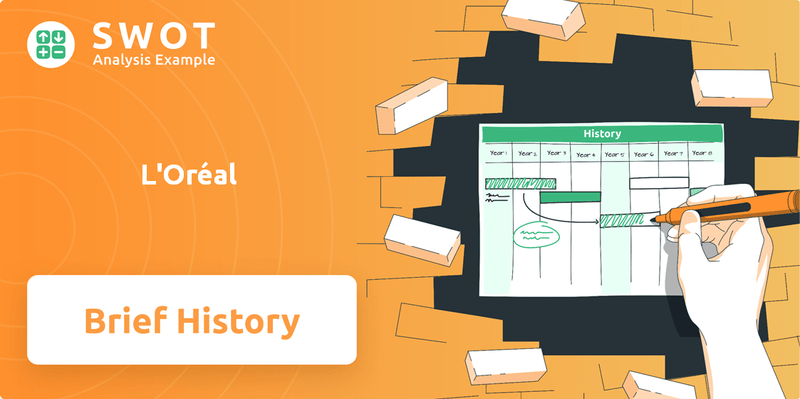
This exploration of the L'Oréal company begins with its humble beginnings and traces its evolution through key acquisitions and expansions. Discover how L'Oréal's commitment to research and development, coupled with its savvy marketing strategies, propelled it to the forefront of the cosmetics industry. Learn about the L'Oréal timeline, its impact on beauty standards, and its enduring legacy as a global leader.
What is the L'Oréal Founding Story?
The story of the L'Oréal company begins with the vision of Eugène Schueller, a chemist with a passion for innovation. His journey started in 1907 with the creation of a groundbreaking hair dye, marking the initial steps of what would become a global beauty giant. This early innovation set the stage for the company's future, driven by a commitment to science and a keen understanding of the beauty market.
Schueller's dedication to developing safe and effective products led to the official establishment of the Société Française de Teintures Inoffensives pour Cheveux in 1909. This marked a pivotal moment in the L'Oréal history, transforming from a small-scale operation into a registered company. The name L'Oréal, derived from 'Auréale,' reflects the company's early focus on hair care and its evolution within the dynamic cosmetics industry.
The early business model of L'Oréal centered on providing innovative hair colorants to hairdressers, a strategy that quickly established the company's reputation. Schueller's approach, rooted in scientific research and a deep understanding of consumer needs, laid the foundation for L'Oréal's continued success. His entrepreneurial spirit and commitment to quality propelled the company forward, addressing a significant gap in the beauty market and setting the stage for its future expansion. You can also learn more about the Marketing Strategy of L'Oréal.
Eugène Schueller, a chemist, founded L'Oréal in 1909, driven by his invention of a safe hair dye.
- Schueller developed Auréole, a safe hair dye, in 1907.
- The company was initially named Société Française de Teintures Inoffensives pour Cheveux.
- The name L'Oréal was inspired by a popular hairstyle and the word 'auréole,' meaning 'halo.'
- L'Oréal's early focus was on providing innovative hair colorants to hairdressers.
L'Oréal SWOT Analysis
- Complete SWOT Breakdown
- Fully Customizable
- Editable in Excel & Word
- Professional Formatting
- Investor-Ready Format
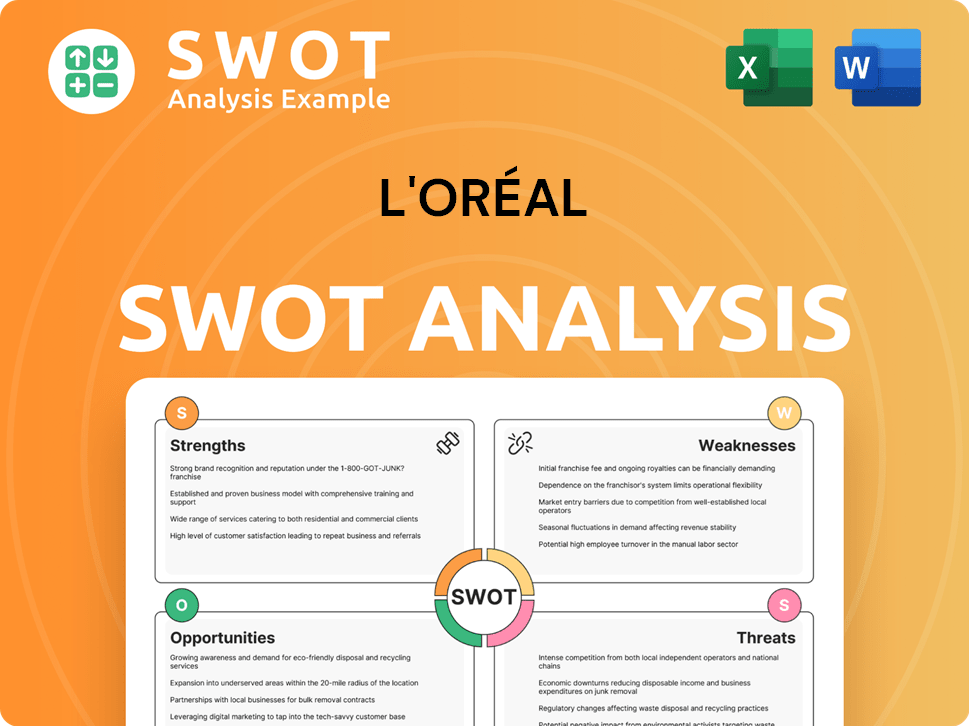
What Drove the Early Growth of L'Oréal?
The early growth and expansion of the L'Oréal company, a significant chapter in L'Oréal history, were marked by strategic product innovations and a keen understanding of market demands. Following World War I, the company capitalized on the evolving beauty trends, particularly the rise of hair salons. This period saw the launch of several key products, laying the foundation for future success in the cosmetics industry.
L'Oréal's early product portfolio included Coloral (hair color), Imedia Liquide (hair tint), and O'Cap (shampoo). These products were designed to meet the growing demand for hair care solutions. These initial offerings were crucial in establishing the company's presence and reputation in the market, setting the stage for further innovation and expansion.
L'Oréal's expansion quickly moved beyond France, entering markets in Austria, Italy, and the Netherlands by 1912. By 1920, L'Oréal products were available in 17 countries, including the United States and Russia. The company officially entered the U.S. market in 1953, demonstrating the early understanding of the importance of the international market.
The 1930s and 1940s saw the introduction of innovative products like Dop (the first modern soap-free shampoo in 1934) and Ambre Solaire (the first tanning oil with a sun filter in 1935). The company's commitment to research and development was evident in the growth of its team of chemists, which expanded from three in 1920 to 100 by 1950. This focus on R&D has been a cornerstone of L'Oréal's success, driving the creation of cutting-edge products.
Strategic acquisitions played a crucial role in L'Oréal's early growth. Under Chairman François Dalle, the company began a period of substantial growth and brand acquisitions starting in 1957. The acquisition of Lancôme in 1964 solidified L'Oréal's position in the luxury beauty market. These moves were pivotal in shaping L'Oréal's trajectory from a small hair dye business to a global beauty conglomerate. You can read more about the company's early days in this article about L'Oréal's history.
L'Oréal PESTLE Analysis
- Covers All 6 PESTLE Categories
- No Research Needed – Save Hours of Work
- Built by Experts, Trusted by Consultants
- Instant Download, Ready to Use
- 100% Editable, Fully Customizable
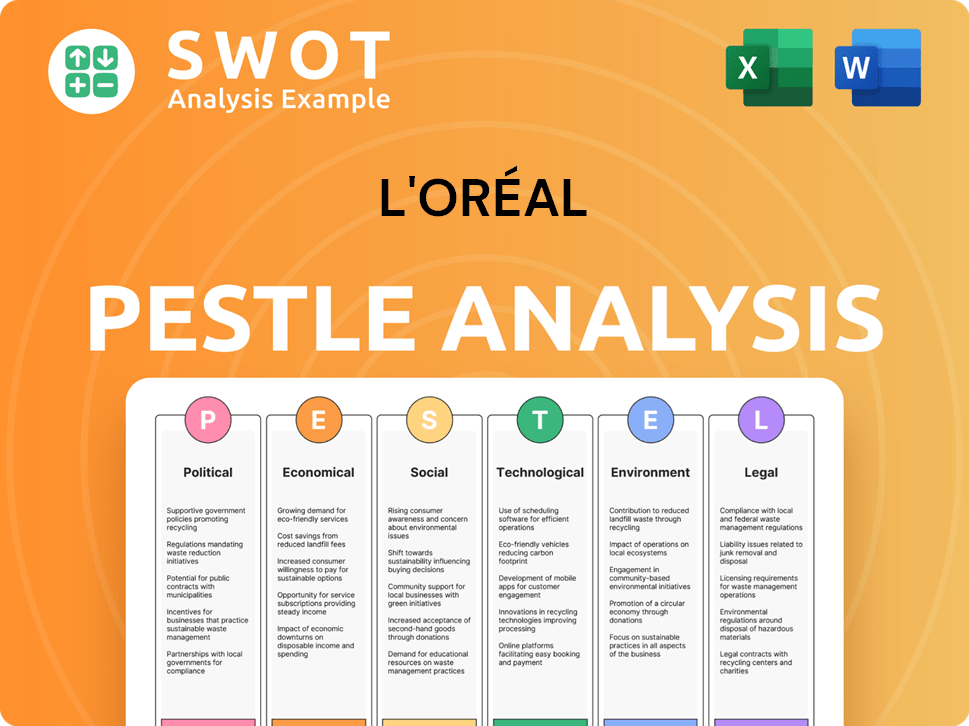
What are the key Milestones in L'Oréal history?
The L'Oréal history is marked by significant milestones, innovations, and strategic responses to challenges in the cosmetics industry. From its early beginnings to its current global presence, the L'Oréal company has consistently adapted and evolved.
| Year | Milestone |
|---|---|
| 1909 | Eugène Schueller, the L'Oréal founder, created the first safe hair dye. |
| 1928 | The company launched the first hair lotion. |
| 1935 | L'Oréal introduced the first sunscreen. |
| 1970s | Préférence, a home hair-coloring brand, launched with the iconic 'Because I'm worth it' tagline. |
| 1979 | L'Oréal developed the first reconstructed skin. |
| 2005 | The company entered the men's skincare market with the Men Expert line. |
| 2024 | L'Oréal introduced a waterless, low-energy fragrance extraction process and acquired the Korean skincare brand Dr.G. |
L'Oréal's key innovations include the application of AI-powered tools such as virtual try-on apps and skin diagnostics, which have significantly enhanced customer engagement and personalization. The Virtual Try-On tool has been used by over 20 million customers worldwide, leading to a 30% higher purchase likelihood for users.
L'Oréal invests over €1.2 billion annually in research and development. The company employs more than 4,000 scientists worldwide.
L'Oréal has numerous industry firsts, including the first hair lotion, sunscreen, and reconstructed skin. In 2023, the company filed 610 patents.
L'Oréal showcases AI-powered tools like virtual try-on apps and skin diagnostics. These tools have enhanced customer engagement.
In 2024, L'Oréal introduced a waterless, low-energy fragrance extraction process. This innovation supports the company's sustainability goals.
L'Oréal acquired the Korean skincare brand Dr.G in December 2024. This move strengthens its position in the skincare market.
L'Oréal entered a long-term global licensing agreement with Miu Miu in 2024. This expands its luxury brand portfolio.
L'Oréal has faced challenges such as market downturns and competitive threats, which it has addressed by adapting product offerings and marketing strategies. The company has also acknowledged falling short of some 2025 sustainability targets, such as its goal for 100% reusable, refillable, recyclable, or compostable plastic packaging, which stood at 49% as of its 2024 Universal Registration Document.
The U.S. market faced challenges in Q1 2025, and China's growth was nearly flat. L'Oréal's response involves a 'beauty stimulus plan' with new product launches.
L'Oréal aims to achieve 100% renewable energy use at all operated sites by 2025. As of December 2024, the company achieved 100% renewable energy for its European operations.
L'Oréal continuously adapts its product offerings and marketing strategies to stay competitive. This includes strategic pivots and acquisitions.
In 2024, L'Oréal acquired a 10% stake in dermatology firm Galderma. This signals a push into medical aesthetics.
The company is expanding its global presence through strategic moves. L'Oréal is focusing on luxury, medical aesthetics, and sustainability.
For more details on L'Oréal's financial aspects, you can explore Revenue Streams & Business Model of L'Oréal.
L'Oréal Business Model Canvas
- Complete 9-Block Business Model Canvas
- Effortlessly Communicate Your Business Strategy
- Investor-Ready BMC Format
- 100% Editable and Customizable
- Clear and Structured Layout
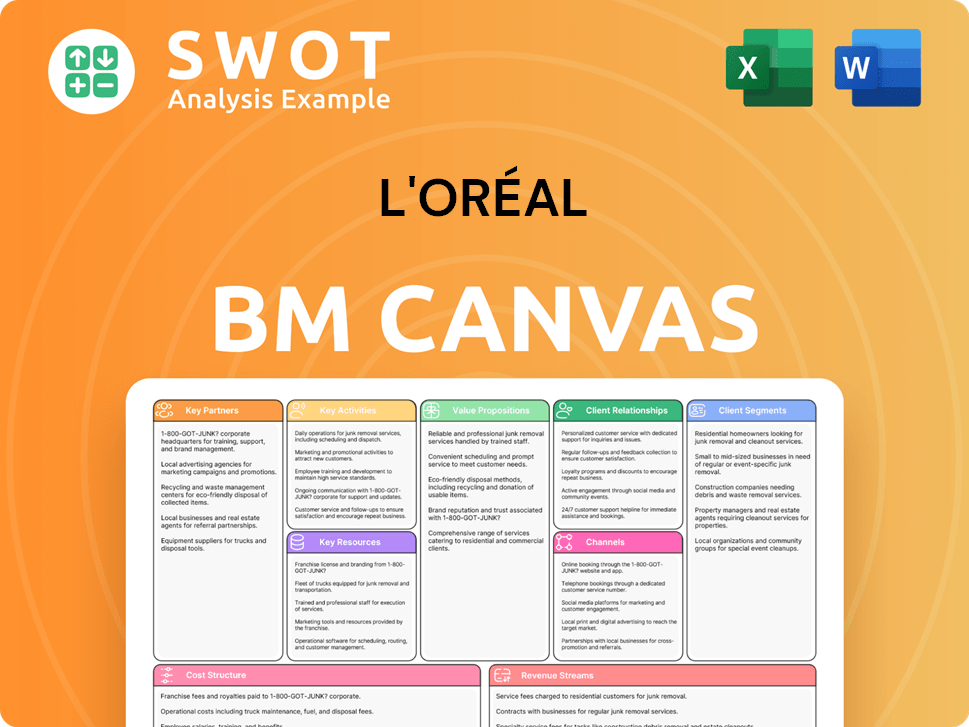
What is the Timeline of Key Events for L'Oréal?
The L'Oréal company has a rich history, marked by significant milestones that have shaped the cosmetics industry. From its early beginnings in 1907 with the invention of the first safe synthetic hair dye by L'Oréal founder Eugène Schueller, to its expansion into international markets in the 1920s, the company has consistently innovated. Key moments include the launch of Dop shampoo in 1934, the introduction of Ambre Solaire in 1935, and the acquisition of Lancôme in 1964, which expanded its portfolio of L'Oréal brands. The 1970s saw the launch of Préférence and the iconic 'Because I'm worth it' tagline. More recent innovations include the launch of iNOA in 2009 and the introduction of the 'L'Oréal for the Future' sustainability program in 2020. In 2024, L'Oréal reported €43.4 billion in sales, a 5.6% increase from the previous year, and achieved 100% renewable energy for its European operations.
| Year | Key Event |
|---|---|
| 1907 | Eugène Schueller invents Auréole, the first safe synthetic hair dye. |
| 1909 | Schueller founds Société Française de Teintures Inoffensives pour Cheveux, later renamed L'Oréal. |
| 1920 | Products are sold in 17 countries, including the U.S. and Russia. |
| 1934 | Launch of Dop, the first modern soap-free shampoo. |
| 1935 | Introduction of Ambre Solaire, the first tanning oil with a sun filter. |
| 1953 | L'Oréal officially enters the U.S. market. |
| 1964 | Acquisition of Lancôme. |
| 1970s | Launch of Préférence and the iconic 'Because I'm worth it' tagline. |
| 1979 | Development of the first reconstructed skin. |
| 1987 | L'Oréal Coiffure becomes the world leader in haircare. |
| 2000 | First eco-designed formula is introduced. |
| 2005 | Entry into the men's skincare market with Men Expert. |
| 2009 | Launch of iNOA, the first ammonia-free permanent hair color. |
| 2015 | L'Oréal debuts at the Consumer Electronics Show, highlighting beauty science. |
| 2020 | Launch of the 'L'Oréal for the Future' sustainability program. |
| 2024 | L'Oréal reports €43.4 billion in sales, a 5.6% rise from the previous year. |
| 2025 | First quarter sales reach €11.73 billion, a 4.4% increase. |
L'Oréal heavily invests in research and development, allocating over €1 billion annually. The focus is on 'Green Sciences' and 'Beauty Tech' to create sustainable and personalized beauty solutions. This includes AI-powered tools for virtual try-ons and skin diagnostics, and a partnership with IBM to develop a generative AI formulation model for product innovation.
The 'L'Oréal for the Future' program sets ambitious goals for 2030, including a 50% reduction in CO2 emissions per product sold. The company aims for 100% recyclable, refillable, reusable, or compostable packaging. By 2030, all manufacturing sites aim to have waterloop recycling systems.
The global beauty market is expected to grow between 4% and 4.5% in 2025. L'Oréal anticipates accelerating growth in the second half of the year, driven by new product launches and strong brand support. Strategic acquisitions and partnerships are also key to strengthening its market position.
In 2025, L'Oréal is recognized as the most future-ready beauty company by IMD. First-quarter sales reached €11.73 billion, a 4.4% increase. CEO Nicolas Hieronimus expresses confidence in L'Oréal's ability to outperform the global beauty market and achieve another year of growth in sales and profit in 2025.
L'Oréal Porter's Five Forces Analysis
- Covers All 5 Competitive Forces in Detail
- Structured for Consultants, Students, and Founders
- 100% Editable in Microsoft Word & Excel
- Instant Digital Download – Use Immediately
- Compatible with Mac & PC – Fully Unlocked
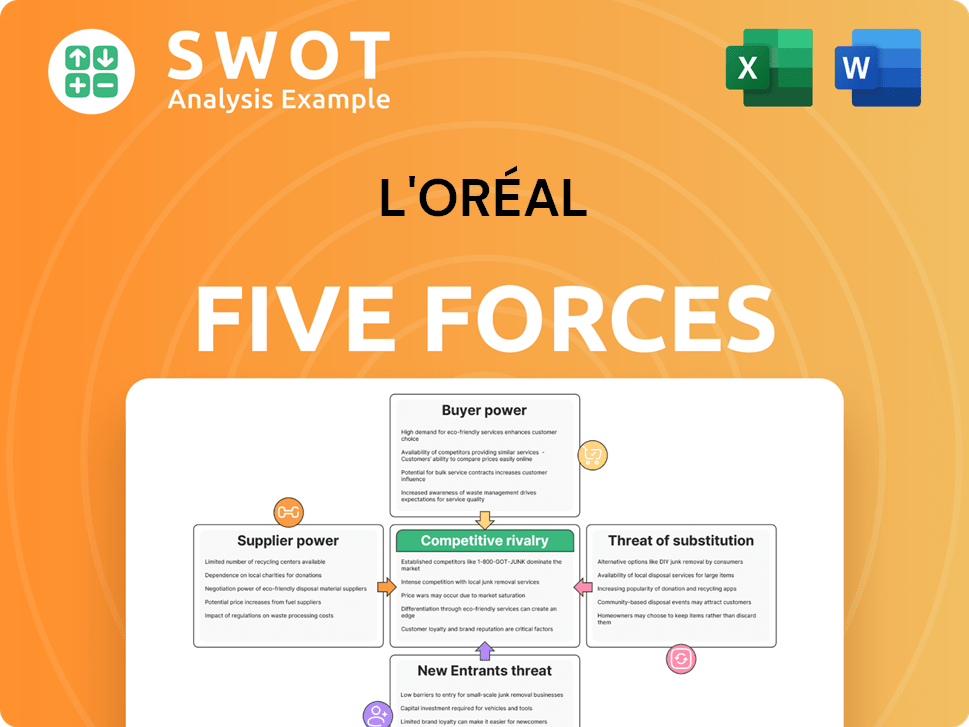
Related Blogs
- What is Competitive Landscape of L'Oréal Company?
- What is Growth Strategy and Future Prospects of L'Oréal Company?
- How Does L'Oréal Company Work?
- What is Sales and Marketing Strategy of L'Oréal Company?
- What is Brief History of L'Oréal Company?
- Who Owns L'Oréal Company?
- What is Customer Demographics and Target Market of L'Oréal Company?
Disclaimer
All information, articles, and product details provided on this website are for general informational and educational purposes only. We do not claim any ownership over, nor do we intend to infringe upon, any trademarks, copyrights, logos, brand names, or other intellectual property mentioned or depicted on this site. Such intellectual property remains the property of its respective owners, and any references here are made solely for identification or informational purposes, without implying any affiliation, endorsement, or partnership.
We make no representations or warranties, express or implied, regarding the accuracy, completeness, or suitability of any content or products presented. Nothing on this website should be construed as legal, tax, investment, financial, medical, or other professional advice. In addition, no part of this site—including articles or product references—constitutes a solicitation, recommendation, endorsement, advertisement, or offer to buy or sell any securities, franchises, or other financial instruments, particularly in jurisdictions where such activity would be unlawful.
All content is of a general nature and may not address the specific circumstances of any individual or entity. It is not a substitute for professional advice or services. Any actions you take based on the information provided here are strictly at your own risk. You accept full responsibility for any decisions or outcomes arising from your use of this website and agree to release us from any liability in connection with your use of, or reliance upon, the content or products found herein.